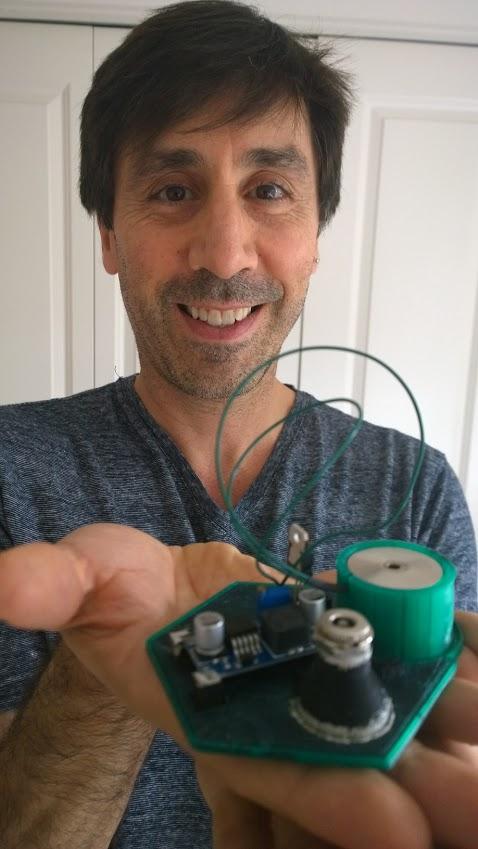Mosaic Manufacturing 3D Prints a Working Flashlight Using Functionalize F-Electric Conductive Filament
 My youngest son has always had a thing for flashlights — put one in his hand and he can’t put it down. He’ll gladly show you the way in the dark, but it doesn’t end there as he usually does a complete light show resulting in temporarily blinding the whole family, and then settles down to take the whole thing apart with scientific curiosity before someone ends up confiscating everything.
My youngest son has always had a thing for flashlights — put one in his hand and he can’t put it down. He’ll gladly show you the way in the dark, but it doesn’t end there as he usually does a complete light show resulting in temporarily blinding the whole family, and then settles down to take the whole thing apart with scientific curiosity before someone ends up confiscating everything.
Imagine a world where the little mad scientist could take matters into his own hands and start printing an entire factory of flashlights from his ‘lab’ at home. Soon that may be the case though, as Mosaic Manufacturing points out. They’re now employing Functionalize’s F-Electric ultra-conductive 3D Printing Filament, still in the middle of a Kickstarter campaign, to produce their own first 3D printed flashlight.
We covered the story of Functionalize’s Kickstarter launch in November, as they embarked on raising $100,000 to set up a production facility for Functionalize F-Electric, created by Seattle scientist and entrepreneur Mike Toutonghi, the founder of Functionalize.
The F-Electric filament is exponentially more conductive — and that’s no understatement, as Toutonghi estimates that it is a thousand times more conductive than any other filament — allowing ‘makers’ to 3D print electrical components directly into models and prototypes produced from 3D PLA capable printers. With only five days left on the Functionalize Kickstarter campaign, they must be thrilled to hear of Mosaic Manufacturing’s 3D printed flashlight.
Mike Toutonghi envisions a world where soon we will be able to operate as our own one-stop shops for electronics in the comfort of our own homes and workshops, with 3D printers whirring away, producing our own cell phones, wearable devices, and electrical components. The filament works with 3D printers using PLA so that you don’t have to buy a new printer just to create 3D printed pieces with electrical or mechanical capabilities.
Using SEEM technology with a single extruder, the folks at Mosaic Manufacturing were able to 3D print their part with a circuit inside it. With the addition of a battery to juice it up and a light source to make it function, the team at Mosaic Manufacturing was pretty excited not just about making their flashlight, but at considering the implications for the future and what it holds in terms of innovation and ease in production.
 They do make it look awfully simple (see the videos below). I think a great deal of the joy and enthusiasm in discovering they could make the flashlight does stem from the simplicity involved through the use of Functionalize’s conductive filament — because yes, the process of creation is indeed a whole lot easier when you can just print the electronics right in your 3D printer.
They do make it look awfully simple (see the videos below). I think a great deal of the joy and enthusiasm in discovering they could make the flashlight does stem from the simplicity involved through the use of Functionalize’s conductive filament — because yes, the process of creation is indeed a whole lot easier when you can just print the electronics right in your 3D printer.
Mosaic Manufacturing, based in Ontario, is committed to bringing multi-color 3D printing to everyone with simple ‘plug and play’ setup for transforming your single-color 3D printer by allowing multi-colour functionality from a single extruder. Their software and technology works with almost all 3D printers on the market.
Have you used any Mosiac Manufacturing’s technology yet? Are you involved in 3D printing electronics? Tell us about your experiences in the 3D Printed Flashlight forum at 3DPB.com.

Subscribe to Our Email Newsletter
Stay up-to-date on all the latest news from the 3D printing industry and receive information and offers from third party vendors.
You May Also Like
Gorilla Sports GE’s First 3D Printed Titanium Cast
How do you help a gorilla with a broken arm? Sounds like the start of a bad joke a zookeeper might tell, but it’s an actual dilemma recently faced by...
Nylon 3D Printed Parts Made More Functional with Coatings & Colors
Parts 3D printed from polyamide (PA, Nylon) 12 using powder bed fusion (PBF) are a mainstay in the additive manufacturing (AM) industry. While post-finishing processes have improved the porosity of...
$25M to Back Sintavia’s Largest Expansion of Metal 3D Printing Capacity Since 2019
Sintavia, the digital manufacturing company specializing in mission-critical parts for strategic sectors, announced a $25 million investment to increase its production capacity, the largest expansion to its operations since 2019....
Velo3D Initiates Public Offering in a Bid to Strengthen Financial Foundations and Drive Future Growth
Velo3D (NYSE: VLD) has been among a number of publicly traded 3D printing firms that have attempted to weather the current macroeconomic climate. After posting a challenging financial report for 2023,...
































